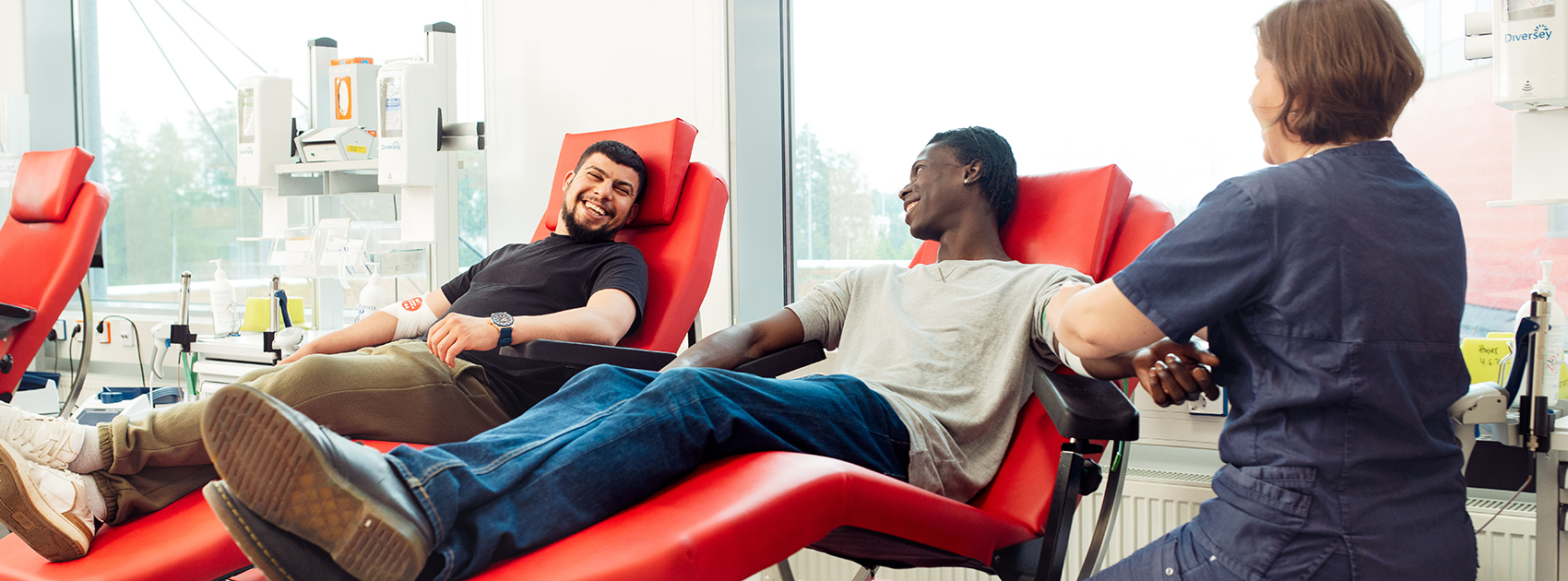Blood Donation
We collect blood for patients based on needs of hospitals. Our goal is to have a sufficiently broad and diverse donor base to quickly respond to changing patient needs.

Blood can be donated at ten Blood Service locations and nearly 1,300 blood donation events in various towns, military garrisons, campuses, and workplaces.
Whole blood was collected from donors in Finland a total of 170,365 times during the year. Blood donation events accounted for 45% of these donations.
The new blood donation bus, introduced at the end of 2023, established its operations by touring shopping centers, workplaces, and campuses in the Helsinki metropolitan area. The bus registered a total of 3,444 visits and made visits also to some other Finnish towns. Military garrison donations are particularly important for reaching new donors. In 2024, 32 visits were organized in 11 units, registering a total of 2,625 donors, of which over 2,000 were new donors.
In addition to whole blood, we collected plasma 1,768 times and platelets 1,604 times at our new Vantaa location. At the Helsinki location, we also collected whole blood for a new type of whole blood product used in emergency care, a total of 257 times.
There were 110,681 individual blood donors, representing 3.1% of the age-appropriate population. For crisis preparedness and changing patient needs, this proportion is too small, so it is important to grow and renew the donor base. We registered 18,052 new donors, falling short of the target by about 3,000 donors. However, we succeeded in increasing the proportion of male donors. The proportion of men was 45%, whereas a few years ago it was just over 40%.
Finland needs more donors of different ethnic backgrounds to ensure that blood products needed for patient care are available from rare blood groups as well. The proportion of donors conducting their blood donation in English increased to 2.1% in 2024. This is a good sign of increasing diversity in the donor base.
We expanded the donor app to work also in Swedish and English, supporting the diversity of the donor base. The app is also important for operational preparedness, as it was updated with an emergency message feature, allowing the Blood Service to provide direct instructions to donors in case of major accidents, for example.
Blood group distribution among donors
Patients need blood products according to the blood group distribution.
Whole Blood Donations
Whole Blood Donations 2015-2024. Blood is collected in line with the needs of hospitals.
Blood donors’ age and gender distribution, registered donors 2024
The group with the most blood donors is young women.
Number of Donations per different person in 2024
In Finland blood donors donate blood 1.57 times per year on average.
Donor invitations and call center services
| 2023 | 2024 | |
|---|---|---|
| Number of invitations | 1 411 090 | 1 417 670 |
| Response within 7 days of invitation | 5,3 % | 5,3 % |
| Proportion of those invited out of those registered | 43 % | 40 % |
| Persons invited for special products | 547 | 577 |
| Number of calls to donor info | 27 958 | 18 995 |
| Newsletters | 2 255 470 | 2 726 773 |
Most common donor deferrals in 2024 (% of those registered for donation)
| 2022 | 2023 | 2024 | |
|---|---|---|---|
| Low haemoglobin | 1,8 % | 1,7 % | 1,8 % |
| A medical condition or ongoing assessments for a medical condition (e.g. a heart or kidney condition) | 1,7 % | 1,6 % | 1,7 % |
| Travel (non-malaria areas) | 0,4 % | 0,5 % | 0,6 % |
| Medication or vaccination | 0,4 % | 0,4 % | 0,5 % |
| Surgery or dental care | 0,4 % | 0,4 % | 0,4 % |
| Common cold | 0,4 % | 0,4 % | 0,4 % |
| Endoscopy, tattooing, piercing, acupuncture | 0,3 % | 0,3 % | 0,3 % |
| Travel in malaria areas | 0,1 % | 0,2 % | 0,2 % |
| Cancer | 0,1 % | 0,1 % | 0,1 % |
| A new sexual partner or another obstacle related to sexual activity | 0,1 % | 0,1 % | 0,1 % |
| Childbirth, breastfeeding | 0,1 % | 0,1 % | 0,1 % |
Percentage of non-donors out of those registered (%)
| 2022 | 2023 | 2024 | |
|---|---|---|---|
| New donors | 14,5 % | 15,0 % | 17,4 % |
| Previous donors | 5,0 % | 5,2 % | 5,6 % |
| Female | 7,2 % | 7,3 % | 7,8 % |
| Male | 4,5 % | 5,1 % | 5,8 % |
| Total - all of Finland | 5,9 % | 6,2 % | 6,8 % |